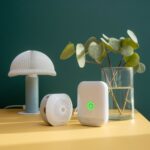Table of Contents
Introduction
In today’s fast-paced world, technology continues to revolutionize our daily lives, and one of the most significant advancements is smart home automation. This innovative approach allows homeowners to control various aspects of their home environment through smart devices and applications. From security systems to energy management, smart home automation not only offers convenience but also improves safety, efficiency, and overall quality of life. In this comprehensive guide, we will explore what smart home automation is, its benefits, the essential components, and practical tips for getting started.
What is Smart Home Automation?
Smart home automation refers to the integration of technology in residential spaces that enables the remote control and monitoring of various devices and systems within the home. This includes but is not limited to:
- Lighting: Smart bulbs and lighting systems that can be controlled remotely.
- Heating and Cooling: Thermostats that learn your schedule and preferences.
- Security Systems: Cameras, alarms, and locks that can be managed via smartphone apps.
- Entertainment Systems: Smart TVs, speakers, and streaming devices.
- Appliances: Refrigerators, ovens, and coffee makers that can be controlled remotely.
By connecting these devices to a central hub or a smartphone app, homeowners can manage their entire home environment from anywhere in the world.

The Benefits of Smart Home Automation
1. Enhanced Convenience
One of the most significant advantages of smart home automation is the convenience it brings to daily life. With the ability to control devices remotely, homeowners can adjust their home environment without being physically present. For example, you can turn off lights left on in an empty room, adjust the thermostat while at work, or start the coffee maker before getting out of bed, all from your smartphone.
2. Improved Security
Smart home automation significantly enhances home security. With smart security systems, homeowners can monitor their property in real time through cameras and alerts. Many systems allow for remote access to view live feeds or receive notifications if suspicious activity is detected. Additionally, smart locks enable you to lock and unlock your doors remotely, providing peace of mind while you’re away.
3. Energy Efficiency
Smart home automation can lead to substantial energy savings. Smart thermostats, for instance, can learn your habits and adjust the heating or cooling based on when you’re home or away, optimizing energy usage. Smart lighting systems can automatically turn off when rooms are unoccupied, reducing unnecessary electricity consumption. These efficiencies not only save money on utility bills but also contribute to environmental sustainability.
4. Increased Home Value
Investing in smart home automation can increase the value of your property. Many potential homebuyers are attracted to homes with smart features, viewing them as modern and efficient. As technology continues to advance, having a fully automated home can set your property apart in a competitive market.
5. Greater Control and Customization
With smart home automation, homeowners have unprecedented control over their living environment. Most smart devices can be customized to suit individual preferences and routines. For instance, you can create lighting scenes for different activities, adjust thermostat settings based on the time of day, and set security systems to trigger at specific times.
Essential Components of Smart Home Automation
To create a fully automated home, you’ll need several key components. Here are some essential devices to consider:
1. Smart Hub
A smart hub acts as the central control system for all your smart devices. It allows different devices to communicate with each other and can be managed through a single app. Popular smart hubs include Samsung SmartThings, Amazon Echo Plus, and Google Nest Hub.
2. Smart Lights
Smart lighting systems, such as Philips Hue or LIFX, allow you to control the brightness, color, and timing of your lights through an app or voice command. You can set schedules, create scenes, and even sync your lights with music or movies.
3. Smart Thermostat
Smart thermostats, like the Nest Learning Thermostat or Ecobee, adjust your home’s temperature based on your preferences and habits. These devices learn your schedule and can be controlled remotely, providing both comfort and energy savings.
4. Smart Security Cameras
Smart security cameras, such as Arlo or Ring, provide real-time video feeds of your home. These devices can send alerts to your phone if they detect motion, allowing you to monitor your property from anywhere.
5. Smart Locks
Smart locks, like August Smart Lock or Schlage Encode, allow you to lock and unlock your doors remotely. Many models come with features like keyless entry and the ability to grant temporary access to guests.
6. Smart Appliances
Smart appliances, including refrigerators, ovens, and washing machines, can be controlled through apps. For example, you can preheat your oven while you’re still at the store or receive notifications when your laundry is done.
Getting Started with Smart Home Automation
1. Assess Your Needs
Before diving into smart home automation, consider what aspects of your home you want to automate. Do you prioritize security, energy efficiency, or convenience? Assessing your needs will help you select the right devices and systems.
2. Choose a Smart Hub
Select a smart hub that is compatible with the devices you want to use. Research the ecosystem of devices that work with each hub to ensure you have access to a wide range of options.
3. Start with Key Devices
Begin with a few key devices that address your immediate needs. For instance, start with a smart thermostat and smart lights, then gradually expand to include security cameras, locks, and other appliances.
4. Integrate Voice Assistants
Consider integrating voice assistants like Amazon Alexa, Google Assistant, or Apple Siri into your smart home setup. These assistants allow for hands-free control of your devices and can streamline your automation experience.
5. Create Routines
Once your devices are set up, create routines or automations that work for you. For example, set up a “Good Night” routine that turns off lights, locks doors, and lowers the thermostat with a single command.
6. Stay Informed
Technology in the smart home space is constantly evolving. Stay informed about new devices, updates, and features to enhance your home automation experience continually.
FAQ Section
What is smart home automation?
Smart home automation refers to the integration of technology in residential spaces that allows homeowners to control and monitor various devices and systems remotely.
What are the benefits of smart home automation?
The benefits of smart home automation include enhanced convenience, improved security, increased energy efficiency, higher home value, and greater control over your living environment.
How do I get started with smart home automation?
To get started, assess your needs, choose a smart hub, start with key devices, integrate voice assistants, create routines, and stay informed about new technologies.
Can I integrate different brands of smart devices?
Yes, many smart devices are designed to work together across different brands, especially if they are compatible with popular smart hubs.
Is smart home automation secure?
While smart home automation offers security features, it’s essential to follow best practices, such as using strong passwords, enabling two-factor authentication, and keeping your devices updated.
How can smart home automation save me money?
Smart home automation can save money through energy-efficient devices that reduce utility bills and enhanced security systems that deter theft and loss.
What devices should I prioritize for a smart home?
Start with essential devices like a smart thermostat, smart lights, and a smart security system. Gradually expand your setup based on your specific needs and preferences.
Conclusion
Smart home automation represents a remarkable advancement in home technology, providing unparalleled convenience, security, and energy efficiency. By integrating smart devices into your living space, you can transform your home into a more intelligent and responsive environment. As technology continues to evolve, staying informed and adaptable will ensure you make the most of your smart home automation journey. Embrace the future of living, and experience the benefits that smart home automation has to offer!

